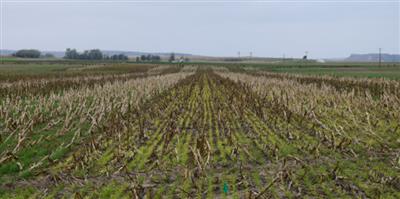After a hail storm destroyed a 130-acre corn crop at the Sustainable Agriculture Research and Extension Center (SAREC) near Lingle on July 27, researchers shifted to a new study of how to recover from late-season hail loss. On Oct. 18, SAREC will sponsor a Hail Study Field Day to share initial results.
“We found ourselves in a shared situation with our neighbors, asking how to manage the damaged corn, if we should plant a forage crop, how to supplement our cattle feed, and what were the economics of our different options,” said Carrie Eberle, assistant professor of agronomy and cropping systems at University of Wyoming and SAREC.
The field day starts at 11 a.m. and includes lunch. The event is free, with reservations required by Oct. 14. SAREC is at 2753 State Highway 157.
“We really want growers to look at the different treatments,” said Eberle. “We will be talking about the approaches, what we are seeing so far, and when we expect to have results.”
She stressed they are seeking input on the study from field day attendees and want to learn of attendee’s experiences.
The hail study is designed to address questions such as the following:
- What is the best practice to remove late season hail damaged corn from the field?
- What is the best forage cover crop to plant following late season hail damaged corn?
- What impacts do management and crop choice have on the next year’s cash crop?
- What are the economic costs and gains for each treatment?
- What are the considerations for livestock value, erosion control, nutrient cycling, soil cover and fertility, hay and grazing value and corn yields?
Corn management treatments being tested are stalk shredding in the field; tilling the standing corn with two passes of a disk; stalk shredding followed by one pass with a disk and one pass with a Landstar; and leaving the corn standing,
The performance of forage crops is being measured in each of the corn management treatments. Crops planted August 20 are winter wheat, winter rye, triticale, sorghum and triticale-sorghum mix.
“We will be evaluating how well each crop establishes in each corn management treatment, how much biomass is produced this fall and through next spring and impact on corn performance next year,” Eberle said.
There were 207 hail events in Wyoming in 2015 and more than 500 in Nebraska, according to the National Oceanic and Atmospheric Administration.
The mission of the Sustainable Agriculture Research and Extension Center is to serve the citizens of Wyoming, the region and the nation by facilitating discovery, dissemination and dialog about integrated agricultural systems that are ecologically sound, economically viable and socially acceptable.
For more information about the field day or to make reservations, contact Kelly Greenwald at (307) 837-2000 or kgreenwa@uwyo.edu.
For more information about the studies, contact Eberle at (307) 837-2000 or carrie.eberle@uwyo.edu.
Source: University of Wyoming Extension
Photo credits University of Wyoming: Hail study field with forage crops direct drilled into standing corn. Sorghum is in the center, winter wheat on the right and rye on the left.


